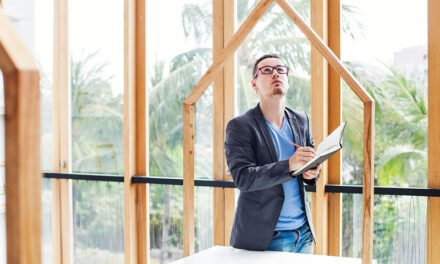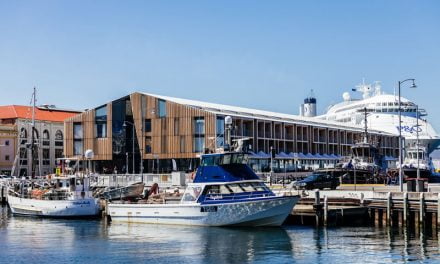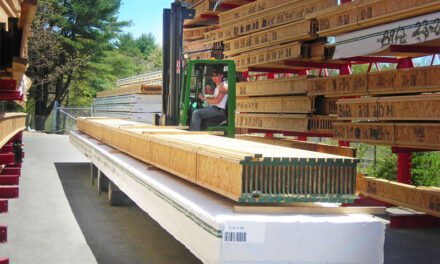Clients love a deck, but don’t always treat them right. Timber suppliers have responded with highly durable but still wholly attractive options. By Donyale Harrison
Smooth timber underfoot; the gentle warmth of lying on wood in the spring sun; eating dinner outside as the daylight lengthens – everyone has a good memory associated with decks, whether at home, on holiday or even in public spaces and schools. It’s no wonder they’re ubiquitous in Australia and New Zealand.
But, to quote Matthew Dix, Victorian state manager at Mortim, “You know what you’re meant to do in yearly upkeep. I know what I’m meant to do. Neither of us is actually doing it.” He’s right. My partner and I lived in our old house with its large undercover deck for eight years: I oiled it once.
Accepting that people are people, leading suppliers have increased their range of decking offerings that are resilient and durable, even with a lazy end user.
There’s a wide range of choice on offer, from timber species, to appearance, to upkeep needs, even price points.
Sustainability concerns are being met both by high-quality recycled or sustainably sourced hardwood timbers from companies like Kennedy’s Timbers and also by certified hardwood plantations, which deliver a reliable supply. Alas, Australia is lagging in the latter, and so imports have taken up the slack. While this does add to carbon costs in transport, the exporters have countered this with strategies designed to minimise emissions in the transport itself and to balance this cost with savings elsewhere in production. Additionally, the longer service life of the product itself is a mitigation.
Working alongside timber suppliers, preservative and coating suppliers have low-toxicity treatments that are highly suitable for structures like decks, which are in close contact with people, and easy-to-use oils and touch-up formulations for cut ends and holes. Coupled with a push from many suppliers for pre-oiling decking product so there is full-envelope protection before it’s even installed, suppliers like the following are making decks as user-proof as possible.
ESTONIAN EXPERTISE
Based in Estonia, Thermory offers FSC-certified timbers that are treated using heat and steam to change the internal chemistry of the timber, with no additional chemicals.
The resulting thermowood is lighter than the natural wood pre-treatment, highly resistant to pests and rot, has improved dimensional stability and an attractive appearance and fragrance. The process also improves the heat and sound insulation qualities of the natural wood by up to 30%, meaning decks stay cooler in the summer sun.
“Odd as it sounds, Estonia and Australia have a lot in common when it comes to decks,” says Oksana Skorbatjuk, Thermory’s marketing manager for exteriors. “We’re both nations that like to live outside and so our decks get a lot of use and we both have some challenging weather.”
The stresses of the local conditions meant that when the 25-year-old company went out to non-Baltic European markets, it was confident thermowood would perform well. But Thermory still backed this up with in-depth testing that continues around the world.
“We’ve been testing across Europe for many years,” Skorbatjuk says, “for durability, for rot and for fire, especially as we’ve moved into cladding big public buildings. So, before we moved outside Europe, we could show it performed well everywhere from the far north to Spain, which is a huge range of climates.
“We’ve been in the US for 10 years and Australia for about two-and-a-half years and in both of those markets we began testing product there before we started selling.”
The thermal modification treatment is key to this adaptability, as it gives the timber superior stability in multiple environments. It significantly lowers the moisture content of the boards, meaning they can be used in areas around pools, even in showers and saunas. “As long as it dries out, it can get as wet as you want,” says Skorbatjuk. “The only thing you need to do is wash it regularly, because, as a natural product, it can get slippery or stained with algae or pollen.”
The thermal process itself is far from simple: “We start with careful selection of the timbers we buy,” Skorbatjuk says, “and then the thermokilns are monitored by skilled specialists who treat each species individually and know the best rates of warming and cooling to suit. We’re not the only company using heat treatment, but we’re proud that our product stands out from our competitors on quality.”
Deeon Otto is managing director of Australian Timbers, the local supplier of Thermory. He’s a solid convert, so much so that he’s used it in several projects around his own home. “The main things we’ve seen customers attracted to are the environmental side – they love the company’s commitment to minimising carbon and using certified timber and that the treatment gives a 25-year life with no chemical additives – and also the look of it.
“The heat cooks the sugars in the wood, changing the colour and giving it a very appealing fragrance. The Ash becomes rich and dark and the Pine becomes a beautiful caramel colour. If you choose not to coat it or oil it, over time, the Ash in particular weathers to a beautiful silver colour without deteriorating the timber. As it ages, the surface stays smooth and splinter-free.”
This silvering happens more quickly in thermowood than natural timber. For customers who want to maintain the original colour, an annual oiling with a UV-resistant product will keep the original tones.
“It also doesn’t get hot underfoot on hot days, which is especially helpful in a country like Australia with scorching summers,” says Skorbatjuk. “It stays comfortable to walk and sit on, unlike most options.”
Despite Thermory being comparatively new in the Australian market, Otto has found his customers drawn to the product. “They might come in to buy something else, but then they see these timbers and they ask about them,” he says. “I show them pictures of some of the projects it’s been used on – including my home gate and dog’s kennel – and they start talking about using it on their next project.
“Part of the attraction is the pricing. The Ash is at the higher end, but it’s a boutique product, and it’s certainly competitive with similar hardwoods. The Pine is very well priced, particularly when you consider its appearance and its quality. We stock the two species so we can make Thermory products available to as many of our customers as possible.”

Otto has found Thermory a reliable partner when it comes to supply. “We haven’t had any problems and they’re very efficient at delivery, as well as having excellent marketing and research teams.”
All Thermory products come with detailed information sheets for end users, including an installation guide. “If you’re screwing directly to the spacers and joists, you must use stainless-steel screws, as the acidity level in the Thermory will affect other fixings,” Skorbatjuk cautions. “Alternatively, you can use our hidden fixings, which give a beautiful uninterrupted timber deck. You don’t have to think about what the screw line looks like, and it’s really easy to install.”
The clips attach to the edges of the decking boards and are then screwed into the substructure, so they don’t need stainless-steel screws. Otto adds: “Once you line up the first board and get that in place, the system allows for very quick fixing because all your gaps are set by the clips.”
Australia is a growth market for Thermory, with products currently undergoing testing in Europe planned to arrive here in the next few years. “The timber looks, feels and smells so beautiful, it doesn’t need all its other features to make it worth using,” Skorbatjuk says. “And then it stays that way because it has them.”
AUSTRALIAN TREASURES
Sustainability and supply are also major factors in timber choice at Mortim, a leading timber wholesaler operating out of Adelaide, Melbourne and Brisbane. “We were looking for a durable, certified hardwood that we could reorder with confidence,” says Matthew Dix. “We didn’t want to be in a position where we could only get it for six months and then have to start looking again.”
The company had previously offered spotted gum decking and was hoping to source another Australian hardwood, which Dix and his team found – in Uruguay.
“We find it quite amusing that we’re buying an Australian species from a South American country. We’re bringing it back home, basically,” Dix says.
Flooded Gum, also known as Red Grandis (Eucalyptus grandis) was one of the major timber species planted when Uruguayan forestry decided to focus on hardwood plantations, a project begun in the late 1980s.
“We’re buying from URUFOR, and they’ve been very good with supply,” says Dix. “We wanted that assurance that it was going to be a long-term product.
“The other major criterion we had was that it be sustainably grown and URUFOR sources all its timber from partner COFUSA, which is FSC certified. In fact, Mortim has also become FSC certified as we’ve gone through this process. COFUSA has also been running a genetic program to enhance the quality of their timber since they started and both partners have worked on carbon capture and conservation tillage.”
While this sustainability is important to Mortim, the deciding factor was Flooded Gum’s suitability for decks.
“In itself, it’s a beautiful, light, durable timber,” Dix says. “It’s very stable, and we import it raw and then improve its natural durability with a careful choice of treatment and pre-oiling that gives decks the best chance of a long service life without problems like swelling or cupping.”
Mortim uses Fisher’s Timber Treatment H3 Tru-Core process for the Flooded Gum. “We know that ASH use the same process for their hardwoods and so it made sense to us,” says Dix. “The big advantage is that the treatment penetrates throughout decking boards, so there’s no need for brush-on preservatives when you cut or drill the boards. It’s the same reason we’ve chosen to pre-oil – it gives a little bit more protection to the product both before and after installation and it seals the timber all the way around, so there’s less risk of moisture penetrating from below.”
Here, Mortim uses Intergrain’s Universal Oil, an open-system oil that can be followed up with a water-based or oil-based product for final oiling. Dix says, “We get the pre-oiling done down at Melbourne Timber Coaters: they do an excellent job and they repack it for us into smaller sizes and re-wrap it for us. So it’s a good process that delivers ready-to-sell decking that’s gone through these value-adding steps but is still at a very competitive price, especially for hardwood.”
Decking timber treated with the Tru-Core process comes with a 25-year guarantee against insect attack or fungal decay if it’s installed in accordance with the relevant building codes. “That’s the biggest problem we see with decks,” Dix says. “The retailers we sell to tell us stories of decks that are installed too close to the ground, or without adequate gaps between boards or in other ways that are just inappropriate when it comes to the amount of moisture the timber will be exposed to.
“It’s one of the reasons we’ve done everything we can to make the Flooded Gum decking as durable as possible, but at the same time users need to exercise a bit of sense. The various standards and codes set out clear guides and the builders should ask suppliers what they recommend. For example, we always suggest you put a hardwood deck onto a hardwood substrate. My experience is that doing so gives a bit more stability.”
Mortim is another company that tests thoroughly before bringing a product to market. “We’ve been selling the Flooded Gum for about six to eight months here, especially in the decking and the claddings,” says Dix. “It took us a little while to bring it to market because we wanted to get the product just right, especially with the treatment. In some of our early trials, we found we were over treating it, so we’ve just had to refine a few steps in the process.”
The result is a beautiful blond board sold in a mid-sized 125 x 22mm. “It’s naturally a soft pink-red colour, but the treatment makes it a bit lighter,” Dix says. “It’s very similar in looks to blackbutt or tallowwood and similar light hardwoods. For people who prefer a darker wood, it takes a tinted oil beautifully and you get the lovely soft grain of the gum in a darker tone. We used to stock treated pine decking, spotted gum, merbau and more. The only species we do now for decks are treated pine and the Flooded Gum, because the gum is appropriate for use in such a wide swathe of the market.”
Despite being new to the market, there is already strong feedback from Mortim’s customers, who are passing on very positive responses from their clients. “The proof is in the re-ordering,” says Dix. “Getting the first orders is relatively easy. Repeat orders are a sign that the product is going well and builders are very happy with what the Flooded Gum is doing for them. This is a core species and board size for UROFOR, so we have no stumbling blocks when it comes to ramping up supply down the track.”
DECKING BASICS
Despite the best efforts of suppliers, and merchants, rectifications or failures on decks are still more common than we’d like. Usually the problem is a DIY job gone bad, but even a good builder can sometimes get it wrong, or have a client who wants the impossible. Timber merchants and hardware stores with timber yards may find it helpful to have flyers (which builders can hand on to their clients) that cover key points, such as:
- The number one enemy of decks is moisture, which can cause a litany of problems. Combat this by making sure your deck has:
- sufficient clearance from the ground to allow adequate airflow beneath it;
- recommended spacing between boards so moisture isn’t trapped.
- Outside, above ground timbers (the deck itself) should have natural or modified high durability or be treated with a Hazard Class H3 or above preservative.
- CCA-treated timbers can’t be used for decks in Australia. Treatments based on ACQ, MCA and some LOSP formulations and a variety of proprietary brands, such as MicroPro, the Tan-E Ecowood range and TruCore are all highly suitable for decking.
- For treatments that don’t penetrate the entire thickness of the board, cut ends and holes should be treated with a suitable brush-on preservative.
- Pre-oiled timbers require an application of a quality decking oil, such as Tanacare Timbercoat (which contains mould inhibitors) after laying, unless your timber is suitable to leave uncoated to weather.
- In areas subject to BAL ratings, these also apply to decks, and timber used in decks and deck substructures must meet the appropriate rating for the location.
- Decking substructures in areas rated BAL 12.5 and above must be enclosed to prevent embers being blown underneath.
- In NSW, the Rural Fire Service requires that timbers used in BAL 12.5, BAL 19 and BAL 29 areas for decking (and related structures) should meet a minimum BAL 29, rather than the lower ratings.
- Decking substructures must be able to deal with wetting or have steel or similar in-ground components. Preservative treated H4 and above timbers are suitable for outside in-ground use. Not all timbers with natural Class 1 and 2 Durability are suitable: despite being a hardwood merbau will not cope with in-ground use, while other hardwoods including spotted gum and blue gum require H4 treatment.
The biggest problem our sector faces is misinformation about timber performance, based on poor practice. Educating your customers – including on coatings, pre-oiling and which timbers are best suited to various conditions – can only help.
For more product details, visit www.arxadawoodprotection.com/apac/, www.australiantimbers.com.au, www.kennedystimbers.com.au, www.kopperspc.com.au, www.mortim.com.au and www.thermory.com
Main image: Thermory Benchmark Ash decking installed to just above the water at Pilot House in Norway (Snøhetta Architects). Photo by Paal-André Schwital, courtesy Thermory.












